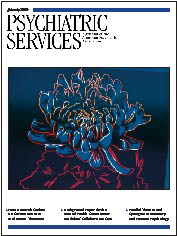To the Editor: The authors of the report, published in the July 2005 issue, of the validation study of the actuarial model of violence risk assessment that was produced by the MacArthur Study (1) correctly state that the study affirmatively answered their research question about whether the model would statistically discriminate patients assessed as "high risk" from those assessed as "low risk" with respect to their actual violence after hospital discharge. As a clinician, however, I would question the authors' implied endorsement of the usefulness of the risk estimates provided by the MacArthur Violence Risk Assessment Study (2)—that is, those utilized by the Classification of Violence Risk (COVR) software (3).
Given the results of the MacArthur Study and the "unrevised" validation sample base rate for violence of 17.8 percent, one would have expected that in the validation study the COVR would have shown positive predictive power of .60 and negative predictive power of .99. However, the instrument in fact exhibited positive predictive power of .35 and negative predictive power of .91. With respect to the "revised" validation study base rate for violence of 22.9 percent, the COVR ought to have shown positive predictive power of approximately .66 and negative predictive power of approximately .99. In fact, it showed positive predictive power of .49 and negative predictive power of .91.
The observed "unrevised" positive predictive power implies that a person classified as high risk by the COVR was actually almost twice as likely to have been nonviolent than violent for the first several months after discharge. The "revised" positive predictive power, although it represents, like the "unrevised" value, an improvement on predicting to the base rate, implies that a person classified as high risk had only a "flip a coin" likelihood of being violent during follow-up. The clinician who has a patient with COVR results that classify the patient in one of the highest risk categories (56 percent or 76 percent) must wonder whether that patient's actual risk of violence is considerably less, given the instrument's performance in the validation study.
It also seems to me that, in vivo, the COVR will be administered not to hospitalized patients in general but only to those deemed for one reason or another to need a risk assessment. This practice could be expected to increase the base rate for violence among patients who are administered the COVR and would most likely increase positive predictive power, while at the same time, unfortunately, reducing negative predictive power (a relative strength of the instrument). Such changes in positive predictive power and negative predictive power could not be computed without reliable estimates of the sensitivity and specificity of the COVR, which, again unfortunately, has shown fluctuating values for those statistics across settings (sensitivity of .96 in the development study but .68 or .75 in the validation study; specificity of .86 in the development study but .72 or .77 in the validation study).
When we also consider the fact that in applied settings there will be no Federal Confidentiality Certificates to promote patients' responding truthfully to the COVR items, I am left with the impression that, pending additional research findings, the instrument has, at best, questionable clinical usefulness.
The author is clinical forensic coordinator with the department of psychology at the Thomas B. Finan Center in Cumberland, Maryland.
1. Monahan J, Steadman H, Robbins P, et al: An actuarial model of violence risk assessment for persons with mental disorders. Psychiatric Services 56:810–815,2005Link, Google Scholar
2. Monahan J, Steadman H, Silver E, et al: Rethinking Risk Assessment: The Macarthur Study of Mental Disorder and Violence. New York, Oxford University Press, 2001Google Scholar
3. Monahan J, Steadman H, Appelbaum P, et al: COVR Classification of Violence Risk. Lutz, Fla, Psychological Assessment Resources, 2005Google Scholar



